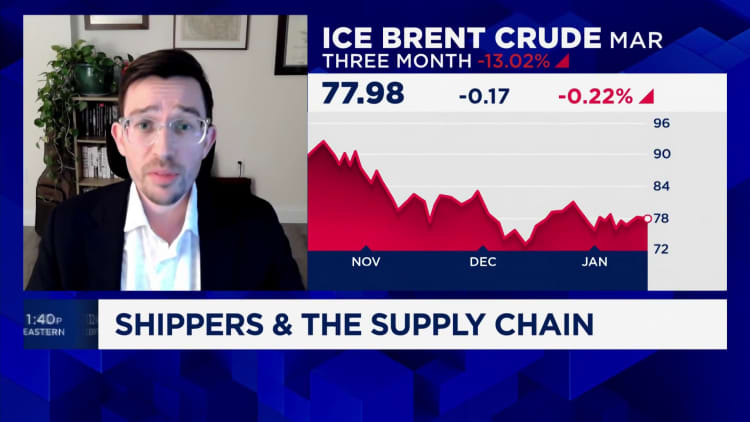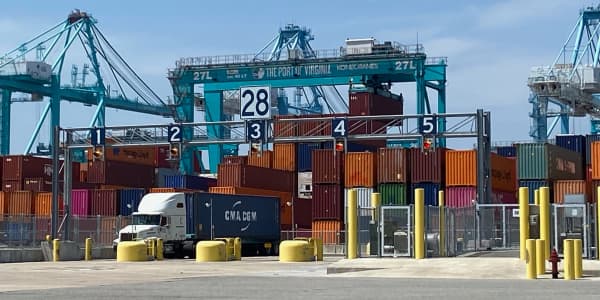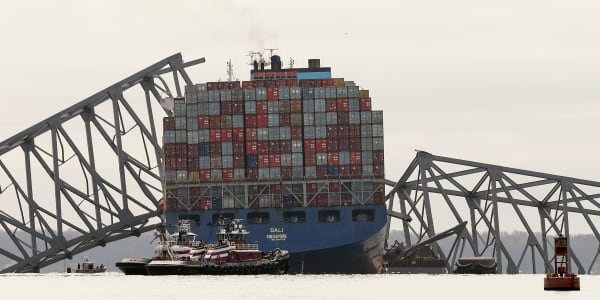The sharp, sudden spike in supply chain inflation caused by the Red Sea crisis and ongoing attacks on shipping vessels by Houthi rebels may have peaked on key global trade routes, based on analysis of the latest data from Xeneta, a leading ocean and and air freight benchmarking platform. It tells CNBC that rates on ocean routes from Asia to Europe and the Mediterranean are beginning to decline, but for U.S.-bound trade, prices are still climbing.
Average February short-term rates for forty-foot containers compared to the last round of general rate increases, implemented on January 16, show a slight decline.
Forty-foot containers originating from the Far East to the Mediterranean per 40-foot container are set to be $5,950 under February's GRIs. On January 16, rates were at the recent peak of $6,050. On the trade route from the Far East to North Europe, rates for 40-foot containers are set to be $4,820 at the start of February, slightly below the peak of $4,850 on January 16.
"Based on the fact the February general rate increases are below anticipated levels, this suggests ocean carriers have been forced to negotiate down with shippers," said Emily Stausbøll, Xeneta market analyst. She added this is the best indication of where the market is headed. "It now appears some shippers are pushing back and managing to agree to lower rates. So, we may see rates begin to flatten or decline sooner than many anticipated in February," she said.
The overall rates are based on an average of all the transactions within each trade route — ocean shipping contracts are not uniformly set, and this is one of the reasons behind the slight decrease. Logistics CEOs tell CNBC they have the ability to negotiate prices down.
Peter Sand, chief analyst for Xeneta, said as individual negotiations take place between shippers and ocean service providers, varied outcomes are to be expected. "Every shipper is impacted differently to the next," said Sand. "That's what creates so much uncertainty in the market because this is not a one size fits all situation."
Some shippers have seen existing contracts honored during this crisis, while some have seen surcharges added. Some shippers have also had their contracts thrown out. "We see differences between how freight forwarders and ocean carriers treat their biggest customers because the power has never really been out of the hands of these extremely large volume shippers," he said.
Rates for cargo headed to the U.S. are still rising
But for U.S companies, while some have negotiating leverage, shipping rates are not seeing any reprieve. According to Sand, rates for the trade route from the Far East to the U.S. East Coast are still heading higher.
Amid the recent freight rate spikes which sent spot container prices as high as $10,000, and resulted in some shippers moving more cargo to air freight, experts have worried about ocean carriers taking advantage of the crisis to excessively jack up prices.
"Everyone is accusing everyone at the moment, which is normal during situations when there is so much uncertainty in the market," Sand said. "Ocean freight carriers did not invent this crisis and it takes time for them to put in new shipping networks to deal with the disruption caused by diverting away from the Suez Canal." However, Sand added, "You can also see this from the shippers' perspective who may view the rate increases as carriers acting opportunistically to maximize the money they can make."

Freight pricing pressure on additional trade routes may soon lessen.
Maritime advisory firm Sea-Intelligence said the average delay for late vessel arrivals has "deteriorated," increasing by 0.30 days month over month to 5.35 days. But Stausbøll said following Lunar New Year, ocean carriers have the opportunity to realign vessel services which would take into account longer transit times around the Cape of Good Hope, which has impacted the delivery of trade.
"There are plenty of ships to manage this increased sailing time, so we would expect other major trades to follow the same pattern as Far East into Europe and see rates flatten or reduce, albeit with a slight delay," Stausbøll said.
She also tells CNBC there should be enough capacity in U.S. ports to handle the Red Sea diversions because demand is so much lower now than in 2021, and there are no longer any Covid-19 restrictions impacting workers in these ports.
Still, other supply chain friction points are surfacing. In a Tuesday hearing on the impact of the Red Sea Crisis held on Capitol Hill, Jon Gold, vice president of supply chain and customs policy at the National Retail Federation, said the NRF was hearing from members that rail-bound container dwell times were starting to tick up.
"Rail car imbalances and increased demand could result in more congestion and increases in dwell," Gold said. "We need to make sure there is chassis availability as well. One of the biggest drivers of congestion during the pandemic was the lack of available chassis."
The NRF was also hearing from members of terminal appointment challenges for trucks to pick up containers.
"Some believe this congestion could begin within the next four to six weeks, after Lunar New Year, when trade volumes start to pick up again," Gold warned.
Paul Brashier, vice president of drayage & intermodal at ITS Logistics, said he is concerned about the ripple effects the Red Sea diversions will have on West Coast ports after Lunar New Year, when many shippers are looking to shift back to the West Coast to avoid the lengthy Cape of Good Hope transit. "At the end of the day, the consumer will suffer the most as significant increases in ocean container rates are passed onto the consumer," he said.
Resilinc, a supply chain mapping, disruption sensing, and analytics company, said the impact of the Red Sea crisis runs deep from a supply chain perspective. "Organizations with deeper pockets are going to weather this disruption with better outcomes," said Bindiya Vakil, CEO and co-founder of Resilinc. "The effects of canceled or delayed orders and increased costs are going to be felt by smaller companies and suppliers in the lower tiers of the supply chain."






